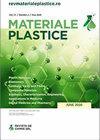消毒方法对三种义齿基托材料中白色念珠菌的影响
IF 0.6
4区 材料科学
Q4 MATERIALS SCIENCE, MULTIDISCIPLINARY
引用次数: 0
摘要
本研究旨在评价消毒液对不同类型义齿材料的白色念珠菌(C.白色念珠菌)的防治效果。采用自聚合丙烯酸树脂、热固化丙烯酸树脂和硬质衬里材料(n = 6),共获得144例(10x10x2 mm)标本。消毒溶液为100%白醋、2%二光酸氯己定(Saver)和Corega义齿清洁片。将标本置于elisa板上,每孔加入酵母提取物蛋白胨(YPD) 1.5 mL。然后在孔中加入30 μ L念珠菌培养液。接下来,将标本在37℃、80 rpm下孵育48 h。在elisa板上添加消毒剂。所有标本将消毒剂更换为无菌水2 mL,以100 rpm保持30 min,取0.1 mL液接种于含有YPD培养基的卫生巾中。孵育后,测定菌垫上的菌落生长情况。随机抽取各组标本进行扫描电镜(SEM)成像。三种义齿材料消毒方法组与对照组比较,差异有统计学意义(p < 0.05)。2%葡萄糖酸氯己定(Saver)消毒剂对三种义齿材料的白色念珠菌ATCC 60193和口腔分离菌最有效。研究发现,清洁标签(Corega)和白醋的效果相似。本文章由计算机程序翻译,如有差异,请以英文原文为准。
The Effect of Disinfection Methods on C. Albicans in Three Types of Denture Base Materials
This study aimed to evaluate the efficacy of disinfectant solutions on Candida albicans (C. albicans) for different types of denture materials. A total of 144 specimens (10x10x2 mm) were obtained from three different materials: autopolymerized acrylic resin, heat-cured acrylic resin, and hard relining material (n = 6). Three disinfectant solutions were used: 100% white vinegar, 2% chlorhexidine digluconate (Saver) and denture cleaning tablets (Corega). The specimens were placed on Eliza plates and 1.5 mL of Yeast Extract Peptone (YPD) was added to each well. Then, 30�L of candida culture was added to the wells. Next, the specimens were incubated at 37�C at 80 rpm for 48 h. Disinfectants were added to the Eliza plates. For all specimens, the disinfectants were replaced with 2 mL of sterile water and kept at 100 rpm for 30 min. Then, 0.1 mL of the liquid was taken and inoculated into the pads containing YPD medium. After incubation, the candida colony growth on the pads was measured. Scanning electron microscope (SEM) images were taken from randomly selected specimens from each group. Statistically significant differences (𝑃 [ 0.05) were found between the disinfectant method groups and the control group for the three types of denture materials. The 2% chlorhexidine gluconate (Saver) disinfectant was the most effective for C. Albicans ATCC 60193 and oral isolate of C. Albicans for all three of the tested denture materials. The effect of cleaning of tabs (Corega) and white vinegar was found to be similar.
求助全文
通过发布文献求助,成功后即可免费获取论文全文。
去求助
来源期刊

Materiale Plastice
MATERIALS SCIENCE, MULTIDISCIPLINARY-
CiteScore
1.40
自引率
25.00%
发文量
99
审稿时长
6-12 weeks
期刊介绍:
Materiale Plastice, abbreviated as Mater. Plast., publishes original scientific papers or guest reviews on topics of great interest.
The Journal does not publish memos, technical reports or non-original papers (that are a compiling of literature data) or papers that have been already published in other national or foreign Journal.
 求助内容:
求助内容: 应助结果提醒方式:
应助结果提醒方式:


